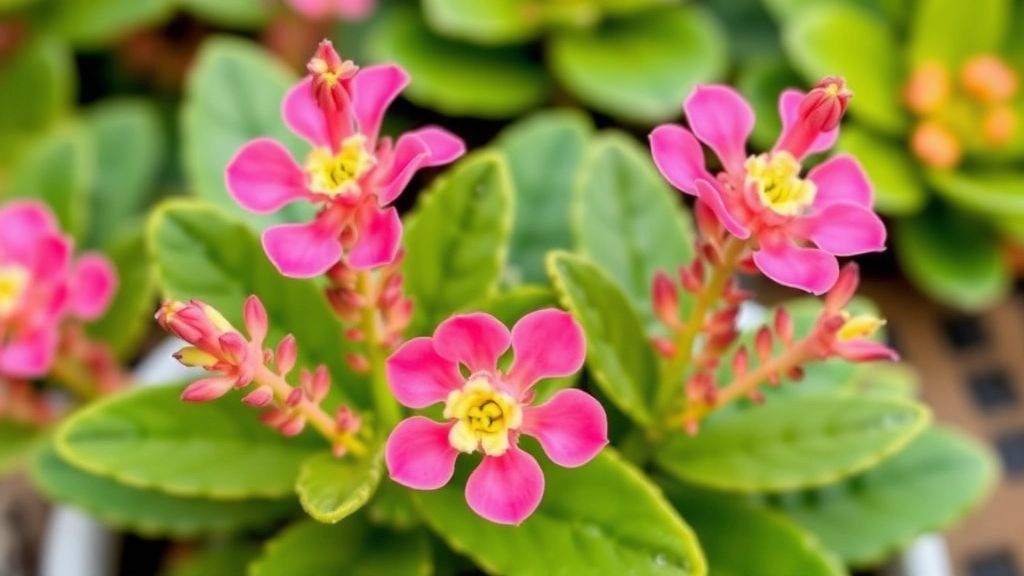Kalanchoe Paddle Plant Flower Care
Light Requirements
When it comes to growing the Kalanchoe Paddle Plant Flower, understanding its light requirements is key. This succulent thrives in bright, indirect sunlight. Too much direct sun can scorch its leaves, while too little light can lead to leggy growth. Finding the perfect balance will ensure your Paddle Plant remains healthy and vibrant.
Watering Guidelines
Watering your Kalanchoe Paddle Plant Flower correctly is another crucial aspect. These plants prefer a “soak and dry” method, meaning you should water thoroughly and then allow the soil to dry out completely before the next watering. Overwatering can lead to root rot, so it’s essential to get this right. Stick to this schedule, and your plant will flourish.
Essential Light Conditions for Paddle Plants
Are you struggling to find the perfect light conditions for your paddle plant?
Understanding the light requirements of Kalanchoe thyrsiflora is crucial for its healthy growth.
Ideal Light Exposure
Paddle plants thrive in bright, indirect sunlight.
Here are some essential tips for providing the right light conditions:
– **Direct Sunlight**: While paddle plants can tolerate some direct sunlight, too much can scorch their leaves. Aim for around 4 to 6 hours of bright light daily.
– **Filtered Light**: If you notice your plant stretching or becoming leggy, it might not be getting enough light. Consider moving it closer to a window with filtered sunlight.
– **Indoor vs. Outdoor**: If you’re growing paddle plants indoors, a south-facing window is ideal. For outdoor plants, ensure they are in a location where they can receive ample sunlight without being exposed to harsh afternoon rays.
Signs of Improper Lighting
Watch for signs that your paddle plant may not be receiving the right amount of light:
– **Yellowing Leaves**: This can indicate too much direct sunlight.
– **Leggy Growth**: If your plant is stretching towards the light, it may need more exposure.
Seasonal Adjustments
Remember, the intensity and duration of sunlight change with the seasons.
In winter, you might need to rotate your plant or move it closer to a light source. For more detailed care tips, you can check out the [care guide for flowering Kalanchoe](https://planthq.org/care-guide-for-flowering-kalanchoe-2030cm-tall-blossfeldiana/) or the [Kalanchoe luciae paddle plant guide](https://planthq.org/how-to-grow-and-care-for-kalanchoe-luciae-paddle-plant/).
Optimal Watering Schedule for Paddle Plants
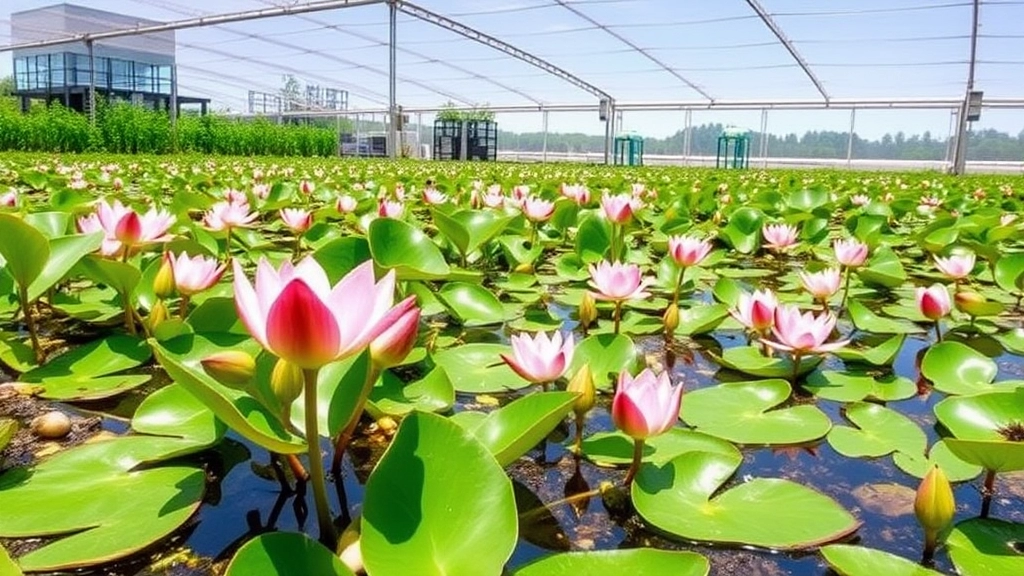
So, you’ve got your Paddle Plant, and now you’re wondering about the best way to keep it hydrated.
Watering can feel like a guessing game, right?
Here’s the scoop: Paddle Plants, or Kalanchoe thyrsiflora, are succulents, meaning they thrive in dry conditions. Overwatering is one of the most common mistakes.
Key Points for Watering:
- Frequency: Water every 2-3 weeks during the growing season (spring and summer).
- Check the Soil: Always poke your finger about an inch into the soil. If it’s dry, it’s time to water.
- Watering Method: Use the “soak and dry” method. Water thoroughly until it drains out the bottom, then let it dry completely before the next watering.
- Seasonal Changes: In winter, reduce watering to once a month or even less. The plant goes dormant and needs less moisture.
Signs of Overwatering:
- Yellowing leaves
- Mushy stems
- Leaf drop
Signs of Underwatering:
- Wrinkled leaves
- Leaf drop
- Stunted growth
By keeping an eye on these signs, you can adjust your watering schedule as needed.
### Soil Requirements and Drainage Tips for Healthy Growth
When it comes to nurturing your Paddle Plants, the right soil can make all the difference. Have you ever wondered why your plants aren’t thriving? Often, it boils down to soil quality and drainage.
#### Ideal Soil Composition
Paddle Plants, or Kalanchoe thyrsiflora, prefer a well-draining soil mix. Here’s what you should consider:
– **Cactus or Succulent Mix**: This type of soil is specifically designed to facilitate drainage.
– **Additives**: Consider mixing in perlite or coarse sand to improve aeration.
– **pH Level**: Aim for a slightly acidic to neutral pH (around 6.0 to 7.0).
#### Drainage Tips
Proper drainage is crucial to prevent root rot, a common issue for Paddle Plants. Here are some tips to ensure your plant remains healthy:
– **Pot Selection**: Use pots with drainage holes. This allows excess water to escape.
– **Layering**: Place a layer of gravel or small stones at the bottom of the pot before adding soil. This helps with drainage.
– **Watering Technique**: Water thoroughly, but allow the top inch of soil to dry out before the next watering.
#### Real-Life Example
I once had a friend who struggled with his Paddle Plant. He was using regular potting soil, which retained too much moisture. After switching to a cactus mix and ensuring proper drainage, his plant thrived like never before. For more detailed care tips, you might find this [complete guide to Kalanchoe Pinnata air plant care](https://planthq.org/complete-guide-to-kalanchoe-pinnata-air-plant-care/) helpful. Additionally, if you’re interested in learning about other Kalanchoe varieties, check out the [care tips for Kalanchoe Blossfeldiana variegated succulents](https://planthq.org/care-tips-for-kalanchoe-blossfeldiana-variegated-succulents/).
Temperature and Humidity Preferences for Kalanchoe Thyrsiflora
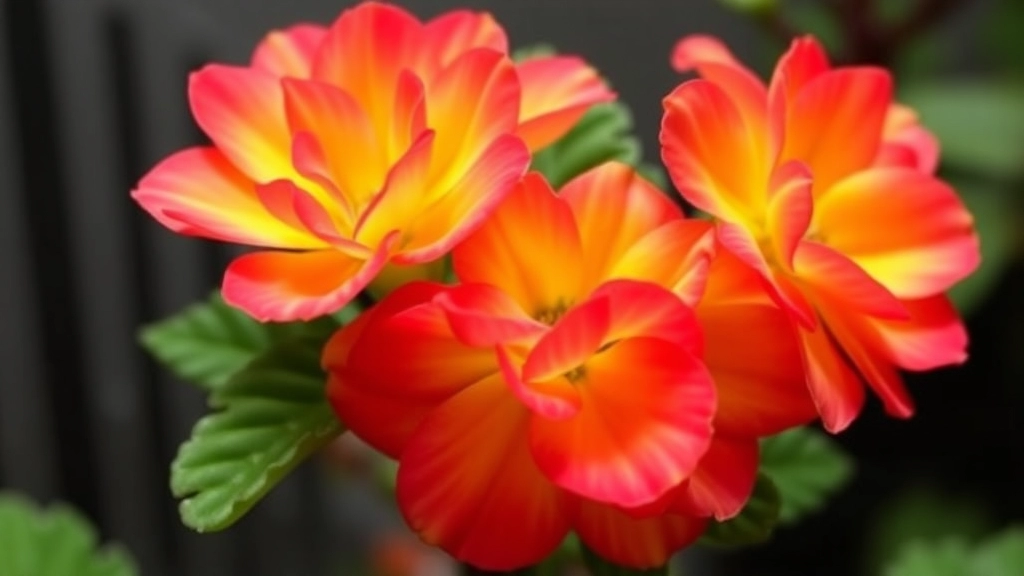
When it comes to nurturing your Paddle Plant, understanding its temperature and humidity preferences is crucial.
What Temperature Does Kalanchoe Thyrsiflora Prefer?
Kalanchoe Thyrsiflora thrives in warm environments. Here are the ideal temperature ranges:
- Daytime: 20°C to 30°C (68°F to 86°F)
- Nighttime: 10°C to 15°C (50°F to 59°F)
Tips for Maintaining Optimal Temperature:
- Avoid Cold Drafts: Keep your Paddle Plant away from windows or doors that open frequently.
- Use a Thermometer: Regularly check the temperature to ensure it stays within the desired range.
- Monitor During Winter: If you live in a cooler climate, consider bringing your plant indoors or using a heat mat.
Humidity Levels:
Kalanchoe Thyrsiflora prefers low to moderate humidity levels. Here’s how to keep it comfortable:
- Ideal Humidity: 30% to 50%
- Avoid Excess Moisture: Too much humidity can lead to rot and fungal issues.
Managing Humidity:
- Use a Humidifier: If your home is particularly dry, a humidifier can help maintain the right levels.
- Group Plants Together: This creates a microenvironment with slightly higher humidity.
- Avoid Misting: Unlike some plants, Paddle Plants do not benefit from misting.
How to Propagate Paddle Plants: Cuttings and Offsets
If you’ve been captivated by the beauty of your Paddle Plant (Kalanchoe thyrsiflora) and wondered how to multiply its charm, you’re not alone. Many plant lovers seek effective ways to propagate their Paddle Plants, ensuring they can enjoy more of these stunning succulents.
Methods of Propagation
- Offsets
- Offsets, or “pups,” are small plants that grow around the base of the parent plant.
- Gently separate the offset from the main plant using clean scissors or your hands.
- Allow the offset to dry for a few hours to form a callous over the cut.
- Plant it in well-draining soil and water lightly.
- Cuttings
- Choose healthy leaves or stems from the parent plant.
- Cut a leaf or stem with a clean knife, ensuring it’s at least a few inches long.
- Let the cutting dry for a day or two, allowing a callous to form.
- Place the cutting in well-draining soil, burying it slightly.
- Water sparingly until roots develop.
Tips for Successful Propagation
- Timing: Spring or early summer is the best time for propagation, as the plant is actively growing.
- Environment: Keep the cuttings in a warm, bright location but out of direct sunlight to prevent scorching.
- Humidity: A humidity dome can help retain moisture, but ensure adequate airflow to prevent rot.
By following these simple steps, you can easily propagate Paddle Plants and expand your collection. For more detailed care tips, check out our Kalanchoe Paddle Plant Care Guide. Additionally, if you’re interested in learning about other Kalanchoe varieties, our guide to Kalanchoe species is a great resource.
Fertilizing Paddle Plants: Best Practices for Growth
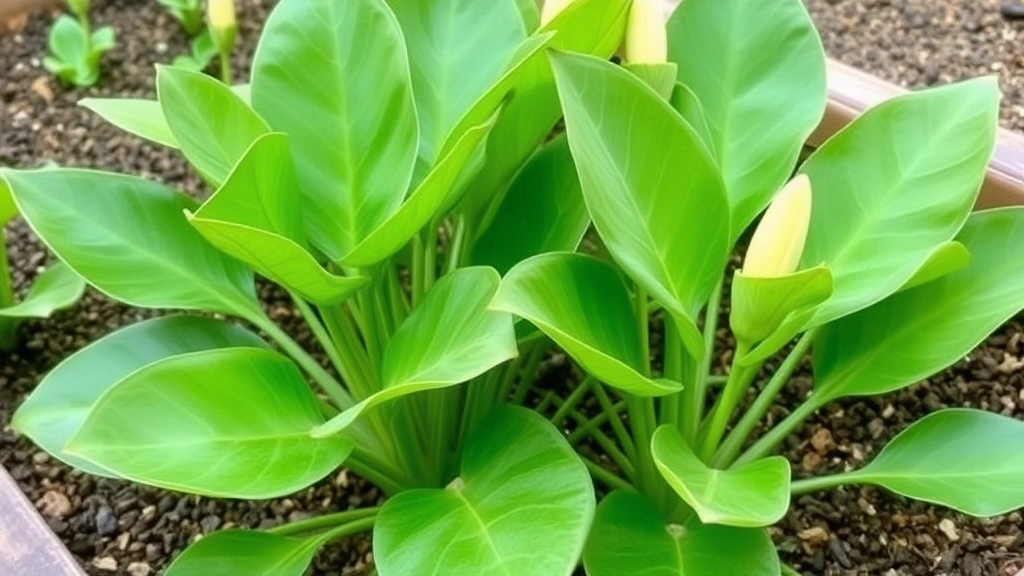
So, you’re wondering how to give your paddle plants that extra boost, right?
Fertilizing is key to keeping your Kalanchoe thyrsiflora thriving and lush.
Here’s the scoop on how to do it right:
- Choose the Right Fertilizer:
- Look for a balanced, water-soluble fertilizer with a ratio like 10-10-10 or 20-20-20.
- Succulent-specific fertilizers are also a great option.
- Frequency Matters:
- During the growing season (spring and summer), fertilize every 4-6 weeks.
- Cut back in the fall and winter when your plant is resting.
- Dilution is Key:
- Always dilute your fertilizer to half the recommended strength. Paddle plants can be sensitive, and too much can do more harm than good.
- Water Before You Feed:
- Water your plant a day before applying fertilizer to prevent root burn.
- Signs Your Plant Needs More Nutrients:
- If your paddle plant looks leggy or the leaves are pale, it might be time to up your fertilizing game.
Remember, less is often more when it comes to fertilizing.
As we delve deeper into the care of paddle plants, it’s essential to address the potential threats posed by pests and diseases.
### Identifying Common Pests
Paddle plants, or Kalanchoe thyrsiflora, can attract a few unwelcome guests. Here are the most common pests to watch for:
– **Mealybugs**: These tiny, white, cotton-like pests often hide in leaf axils and can cause significant damage.
– **Spider Mites**: Look for fine webbing and tiny dots on leaves; these pests thrive in dry conditions.
– **Aphids**: These small green or black insects can cluster on new growth, sucking sap and weakening the plant.
### Signs of Disease
Paddle plants can also face diseases, typically due to overwatering or poor air circulation. Keep an eye out for:
– **Root Rot**: Yellowing leaves and a mushy stem indicate this issue, often caused by soggy soil.
– **Powdery Mildew**: A white, powdery substance on leaves usually results from high humidity and poor airflow.
### Prevention and Management Strategies
To keep your paddle plants thriving and pest-free, consider the following tips:
– **Regular Inspections**: Check your plants weekly for any signs of pests or disease.
– **Proper Watering**: Ensure the soil dries out between waterings to prevent root rot.
– **Air Circulation**: Place your plants in well-ventilated areas to reduce humidity and deter fungal diseases.
– **Neem Oil**: A natural pesticide that can help control pests without harming the plant.
– **Insecticidal Soap**: Effective against soft-bodied insects like mealybugs and aphids.
### Treatment Options
If you encounter a pest or disease issue, here’s how to tackle it:
1. **Isolate Affected Plants**: Prevent the spread of pests or diseases to healthy plants.
2. **Manual Removal**: For larger pests like mealybugs, gently wipe them off with a cotton swab dipped in alcohol.
3. **Spray Solutions**: Use neem oil or insecticidal soap as a preventive measure or treatment.
For more detailed care tips, you might find our [Kalanchoe Paddle Plant Care Guide](https://planthq.org/kalanchoe-paddle-plant-care-guide-tips-for-thriving-growth/) helpful. Additionally, if you’re dealing with issues related to overwatering, our guide on [Fixing Etiolated Kalanchoe Blossfeldiana](https://planthq.org/fixing-etiolated-kalanchoe-blossfeldiana-lighting-and-care-tips/) offers valuable insights.
How to Encourage Paddle Plant Flowering
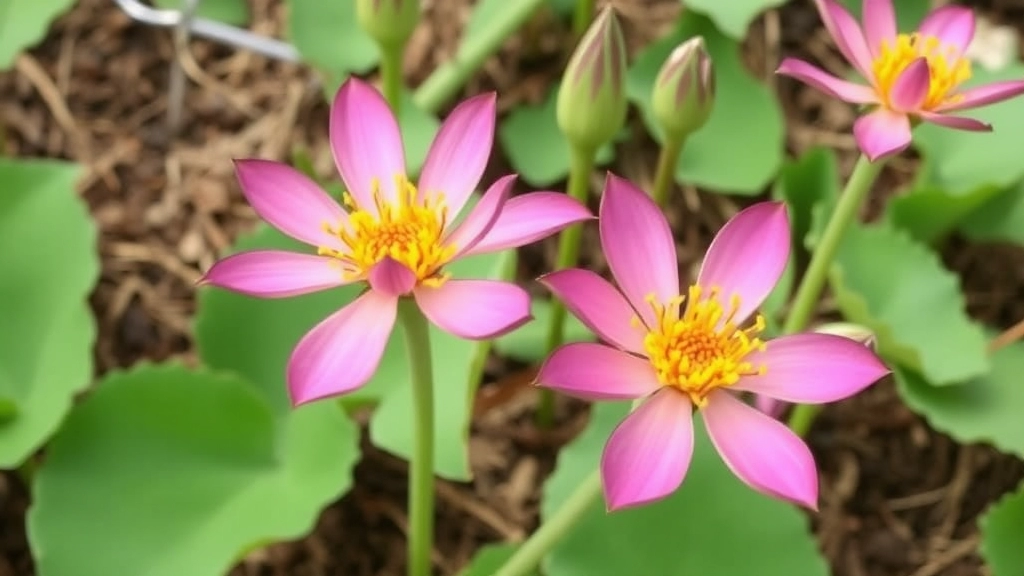
So, you’ve got your paddle plant looking all lush and green, but you’re wondering how to coax those stunning flowers out, right?
Understanding Paddle Plant Flowering
Paddle plants, or Kalanchoe thyrsiflora, can be a bit shy when it comes to blooming. But with the right conditions, you can encourage those vibrant blooms.
Key Tips for Encouraging Flowering
Here’s how to set the stage for a floral show:
- Light Exposure:
- Ensure your paddle plant gets plenty of bright, indirect sunlight.
- Too little light can delay or prevent flowering.
- Watering:
- Water less frequently as the plant matures.
- Allow the soil to dry out completely between waterings. This stress can trigger flowering.
- Temperature:
- Keep the temperature between 18°C to 24°C (65°F to 75°F).
- A little bit of temperature fluctuation can mimic the plant’s natural environment.
- Fertilizing:
- Use a balanced, low-nitrogen fertiliser during the growing season.
- This encourages blooming rather than leafy growth.
- Rest Period:
- Give your paddle plant a rest period in winter.
- Reduce watering and stop fertilising to encourage it to prepare for flowering in spring.
A Little Patience Goes a Long Way
Sometimes, it just takes a bit of patience. Your paddle plant might bloom at its own pace, but sticking to these tips can help speed things along.
IX. The Monocarpic Nature of Paddle Plants: Post-Flowering Care
After the excitement of flowering, many plant enthusiasts face a common concern: what to do next? Paddle plants, or Kalanchoe thyrsiflora, are monocarpic, meaning they flower once and then die. This can be disheartening, but understanding how to care for your plant post-flowering can make the experience much more manageable.
Understanding Monocarpic Plants
- Definition: Monocarpic plants flower once in their lifetime and then perish.
- Paddle Plant Lifecycle: After flowering, the main plant will begin to decline, but don’t despairâthere are ways to ensure the survival of its offspring.
Post-Flowering Care Tips
- Remove the Flowering Stem:
- Once the flowers have faded, cut back the flowering stem to prevent energy drain from the rest of the plant.
- Monitor for Offsets:
- Look for offsets or “pups” around the base of the plant. These are new growths that can be propagated.
- Propagation:
- If you see offsets, carefully detach them and plant them in their own pots. For a detailed guide, check out our article on how to propagate Kalanchoe Mother of Thousands.
- Use a well-draining soil mix to encourage healthy root development.
- Watering Adjustments:
- Reduce watering slightly, as the plant will require less moisture after flowering.
- Ensure the soil dries out between waterings to prevent root rot. For best practices, refer to our Kalanchoe Tomentosa watering guide.
- Fertilisation:
- Hold off on fertilising immediately after flowering.
- Once you see new growth on the offsets, you can start a diluted fertilising schedule.
- Environmental Conditions:
- Maintain the same light and temperature conditions that benefited the plant during its flowering phase.
- Be cautious of sudden changes in humidity or temperature, as these can stress the offsets.
- Patience is Key:
- Understand that the main plant will not recover, but with proper care, the offsets can thrive.
Pruning Techniques for Paddle Plants
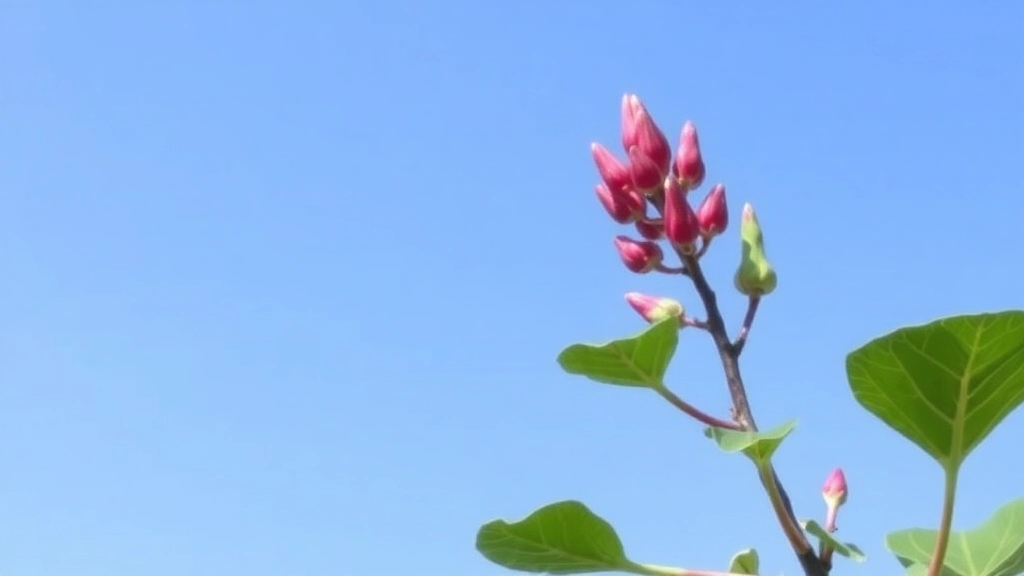
So, you’ve got your paddle plant looking lush and vibrant, but how do you keep it that way? Pruning is a key part of ensuring your Kalanchoe thyrsiflora thrives, and it’s easier than you might think.
Why Prune?
Pruning helps to:
- Remove dead or damaged leaves
- Encourage bushier growth
- Promote better air circulation
- Prevent pests and diseases
When to Prune:
- The best time to prune is in the spring, just as the growing season kicks off.
- If you notice any leaves turning yellow or brown, don’t hesitate to snip those away.
How to Prune:
- Use Clean Tools: Always start with sharp, clean scissors or pruning shears to avoid introducing any bacteria.
- Cut at the Base: For any dead leaves, cut them off at the base to prevent any unsightly stubs.
- Trim for Shape: If your paddle plant is getting leggy, trim back some of the longer stems to encourage a fuller appearance.
- Check for Offsets: If your plant has produced offsets (baby plants), you can carefully remove these and pot them separately.
Post-Pruning Care:
- After pruning, give your plant a little extra TLC.
- Water it lightly and ensure it gets plenty of sunlight to bounce back.
When considering the best potting tips for paddle plants, it’s essential to ensure they thrive in their environment. Whether indoors or outdoors, the right potting setup can make a significant difference in their growth and overall health.
### Choosing the Right Pot
– **Size Matters**: Select a pot that is slightly larger than the current one. A pot that is too large can lead to overwatering issues.
– **Material**: Clay pots are excellent for outdoor plants due to their breathability, while plastic pots are lighter and suitable for indoor settings.
### Drainage is Key
– **Drainage Holes**: Always ensure your pot has adequate drainage holes to prevent waterlogging.
– **Layering**: Consider adding a layer of gravel or small stones at the bottom of the pot for extra drainage.
### Soil Selection
– **Cactus Mix**: Use a well-draining cactus or succulent mix. This helps maintain the right moisture levels.
– **DIY Mix**: You can create your own mix by combining potting soil, sand, and perlite for optimal drainage.
### Positioning Your Paddle Plant
– **Indoor Placement**: Choose a bright spot, ideally near a south-facing window. Avoid direct sunlight that can scorch the leaves.
– **Outdoor Location**: If placing outdoors, ensure they receive partial shade during the hottest parts of the day.
### Repotting Tips
– **When to Repot**: Every 2-3 years, or when the plant outgrows its pot.
– **Gentle Handling**: Be careful when removing the plant from its pot to avoid damaging the roots.
For more detailed care tips, you might find the [Kalanchoe Flapjack Paddle Plant Care Guide](https://planthq.org/kalanchoe-flapjack-paddle-plant-care-guide/) particularly useful. Additionally, if you’re interested in different varieties, the [Exploring Kalanchoe Beharensis Varieties](https://planthq.org/exploring-kalanchoe-beharensis-varieties-care-characteristics/) article offers great insights into care and characteristics.
Common Problems and Solutions for Paddle Plants
So, you’ve got your Paddle Plant thriving, but suddenly, it’s looking a bit off? Don’t sweat it; we’ve all been there. Let’s dive into some common issues you might face with your Kalanchoe thyrsiflora and how to tackle them.
1. Leaves Turning Yellow
What’s Happening?
Yellowing leaves can be a sign of overwatering. It’s like your plant saying, âHey, I’m drowning!â
Solutions:
- Check the Soil: Stick your finger in the soil. If it’s soggy, hold off on watering.
- Adjust Watering Schedule: Water only when the top inch of soil feels dry.
2. Leaf Drop
What’s Happening?
If your Paddle Plant is shedding leaves, it could be stressed.
Solutions:
- Light Check: Ensure it’s getting enough bright, indirect sunlight.
- Temperature Control: Keep it in a warm spot, away from drafts.
3. Stretching Stems
What’s Happening?
Stems that look leggy? Your plant’s reaching for more light.
Solutions:
- Relocate: Move it closer to a light source.
- Rotate Regularly: This helps ensure even growth all around.
4. Pest Problems
What’s Happening?
Tiny critters like mealybugs or aphids can invade your plant.
Solutions:
- Inspect Regularly: Check under leaves and around the base.
- Natural Remedies: Spray with a mixture of water and mild soap to deter pests.
5. Root Rot
What’s Happening?
If the roots are mushy, you’ve got root rotâbig trouble!
Solutions:
- Repot Immediately: Remove the plant and trim away any rotten roots.
- Use Well-Draining Soil: Make sure your pot has drainage holes and use a mix that allows for airflow.
6. Lack of Flowers
What’s Happening?
If your Paddle Plant isn’t blooming, it might need a little extra care.
Solutions:
FAQs about Kalanchoe Paddle Plant Flower
What is the optimal watering schedule for Paddle Plants?
Paddle Plants, or Kalanchoe thyrsiflora, thrive in dry conditions. Water every 2-3 weeks during the growing season (spring and summer) and reduce watering to once a month or even less in winter.
How can I tell if my Paddle Plant is overwatered or underwatered?
Signs of overwatering include yellowing leaves, mushy stems, and leaf drop. Signs of underwatering include wrinkled leaves, leaf drop, and stunted growth.
What temperature and humidity levels do Kalanchoe Thyrsiflora prefer?
They prefer daytime temperatures of 20°C to 30°C (68°F to 86°F) and nighttime temperatures of 10°C to 15°C (50°F to 59°F). Ideal humidity levels are between 30% to 50%.
How often should I fertilize my Paddle Plant?
During the growing season (spring and summer), fertilize every 4-6 weeks. Cut back in the fall and winter. Always dilute the fertilizer to half the recommended strength.
What type of fertilizer is best for Paddle Plants?
Use a balanced, water-soluble fertilizer with a ratio like 10-10-10 or 20-20-20. Succulent-specific fertilizers are also a great option.
How can I encourage my Paddle Plant to flower?
Ensure your Paddle Plant gets plenty of bright, indirect sunlight. Water less frequently as the plant matures and keep the temperature between 18°C to 24°C (65°F to 75°F). Use a balanced, low-nitrogen fertilizer during the growing season and give the plant a rest period in winter.
When and how should I prune my Paddle Plant?
The best time to prune is in the spring. Use clean, sharp tools, cut dead leaves at the base, and trim longer stems for a fuller appearance. Check for offsets and pot them separately if needed.
What are the benefits of pruning my Paddle Plant?
Pruning helps remove dead or damaged leaves, encourages bushier growth, promotes better air circulation, and prevents pests and diseases.
How can I manage humidity levels for my Paddle Plant?
Maintain humidity levels between 30% to 50%. Avoid excess moisture and misting. Use a humidifier if your home is particularly dry or group plants together to create a microenvironment with slightly higher humidity.
What should I do after pruning my Paddle Plant?
After pruning, water the plant lightly and ensure it gets plenty of sunlight to help it recover.
References
-
Kalanchoe Thyrsiflora (Flapjacks) Plant Profile
-
How to Grow and Care for Paddle Plant (Kalanchoe Thyrsiflora)
-
Paddle Plant (Kalanchoe thyrsiflora)
